The early morning sun is hot as it climbs over the mountain and then falls on the plants still soaked with dew. Even though there is the mild discomfort of dust, sunburn and wet clothing, the berry pickers come early to get the biggest and ripest berries on the field. The customers picking their own strawberries arrive early but never as early as the crew which picks for the farm stand. They start just after dawn when there is still an early spring chill in the air because the stand opens early and the stock of berries must be ready.
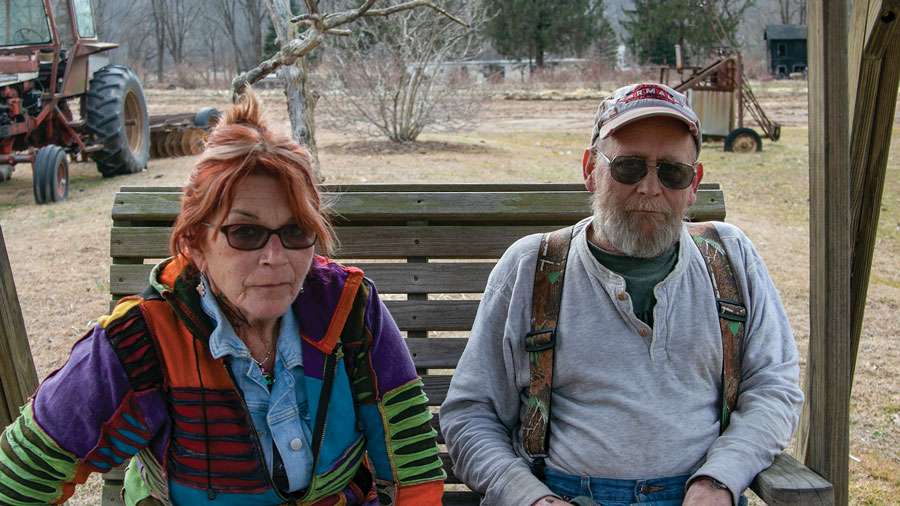
While it may be more an article of faith and not fact, most people believe that a strawberry or a tomato hand planted and hand-picked on a small family farm tastes, feels and looks better than one grown a thousand miles away by The AgriGiant Company and its wholly-owned subsidiaries. Before the advent of corporate farming, all farming was family farming. To the surprise of many, much of it still is.
Marshall’s Farm Stand and Country Store is one of those family farms. It is on U. S. Route 46 in the Township of Knowlton in rural Warren County, five miles downriver from the Delaware Water Gap. The stand is no more than three hundred yards from the Delaware River and the crisp coolness of the river is always present. The stand has been in operation for 101 years, since 1919. In the distant past, the road that is now Route 46 was known locally as Albertson’s Trail, River Road, or Route 6. Soon after the Marshall family’s purchase of their original twenty-five-acre parcel, a small wooden shed was built near the road for the sale of wooden lawn ornaments and bark-covered picture frames made by the members of the family and sold by their seven-year-old son named George. Later, in an example of nothing new under the sun, spring water was sold by the glass or jug to thirsty travelers. The stand was gradually expanded to the one we see today, built George and his friends in the mid-1950s.
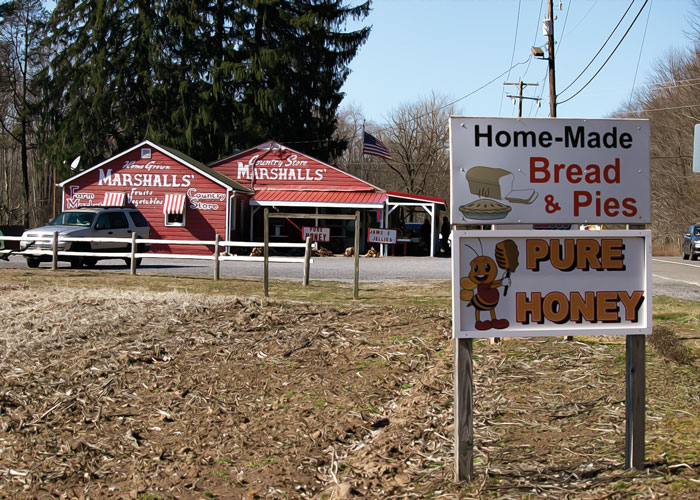
There had been merchants, farmers and other tradesmen on both sides of George’s family, so as he became older and took over, he decided that farming and roadside retail produce sale were how he would supplement his teacher’s income. The Marshall family began growing produce for the stand to sell with flowers and fruit. Believing that a field which produced only one crop of apples in the fall could be better used to grow as many as four crops in a season, George removed many of the spent, unproductive apple trees that grew on his land. On the newly cleared, and other, fields, George planted corn, pumpkins, tomatoes, strawberries, squash, onions, potatoes, pickle cucumbers, peppers, chrysanthemums, sunflowers and loads of other vegetables and flowers. George and his wife, Marion, with the help of their two children, Marianne and Richard, spent most of their free time working the farm and expanding the business.
In 1969, Marianne married her high school sweetheart, Dominic Saponaro, known to all as Nick, and a few years later Nick was working full time on the farm with his father-in-law. As George got older, more and more responsibility for the farm fell to Nick. Today, and for many recent years, Nick and Marianne run the farm and the stand with their respective field and retail crews. They have lived in the Victorian farmhouse at the farm for many years and raised their two sons there.
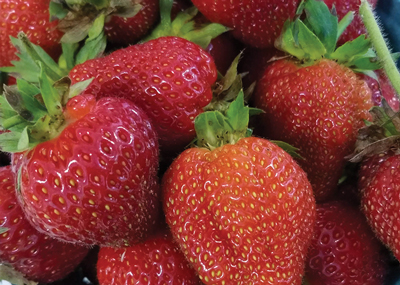
Every month has a draw to the stand. October is for pumpkins and July is for sweet corn. The big attraction and the earliest crop of the year is strawberries during early June. Every year tourists just driving by discover Marshall’s strawberries and return every week to try the different varieties, and then later in the season for other produce. The history and daily process of commercial strawberry farming is a saga with a million details and as many pitfalls.
Strawberries have been cultivated for thousands of years. The Romans gave them the Latin name Fraga which refers to the enticing fragrance of this plant and its fruit. However, the origin of the English name, strawberry, is more obscure. In the fall, straw is used to cover strawberry plants. This serves a multi-purpose. Early spring is often cold, and the straw covering allows the ground to thaw more slowly with less heaving and less of the plant’s roots becoming exposed. Lastly, the fruit stays cleaner because it is on the straw and not on the dirt. Some believe that this method of cultivation gave the strawberry its name.
Nick buys his new strawberry plants from a nursery and gets them in the ground by mid-April. He plows the field in March at the first thaw and then just prior to planting, he discs the field, which evens out the troughs made by the first plowing and leaves the field level with no large clods of earth. To plant, he sets the plants on the planter which is pulled behind the tractor, poking a hole at whatever distance is chosen. Nick drives slowly while his crew sets the plants in the holes, which are covered by the planter’s packing wheels.
Strawberry plants are in rows of about a dozen per acre. Every year at least three acres of strawberries are growing, but only two are producing fruit. A field that has been planted with new plants must have the flowers pulled as soon as they appear so that all the energy can flow into the root systems which are not yet sufficiently developed to nourish a profitable crop of fruit.
Nick is allowed to pump a maximum 100,000 gallons of water each month from the Delaware River to irrigate his fields, none of which is more than seventy-five yards away from the source. Every year he is required to register five pumping locations along the riverbank with the Department of Agriculture, then draws the water with a movable pump towed behind his pick-up from spot to spot. He can cover a one-acre field with one inch of water in three hours through his field pipe network.
“Strawberries are in danger the entire season and I’m never able to completely forget them. But the early spring is the worst,” stated Nick as we discussed his crops. Strawberry plants bloom anytime from late April until mid-May. The fruit begins to grow between the stem and the flower. If the flower is damaged, the fruit will not grow, and this is the time when they are the most vulnerable to frost. The first flower to appear is near the top of the plant, and from it grows what is known as the ‘crown berry’. It draws the greatest amount of nutrients and is usually the biggest and prettiest berry that plant will produce. Being near the top of the plant, however, makes the flower of the ‘crown berry’ the most vulnerable to a frosty dew.
To protect the strawberry flowers from late frost, a light mist of water is sprayed onto the plants. A bubble of ice formed around the flower insulates it from the freezing temperature. The misting process must continue until the temperature rises and the ice bubble thaws, and the pump from the river must be closely monitored. A part could fail, the motor’s vibration could knock the pump from its seating, or a fish could be sucked into the pipe. Nick can only cover one acre at a time, so he must juggle where and when he mists his fields. And he often has to “baby-sit” the pump three or four nights in a row. Nights with little sleep followed by fourteen-hour days of heavy work take a heavy toll. This is when Nick, and other farmers like him, is not as jolly as Mr. Green Jeans.
Over the years, Marshall’s has grown over 150 types of strawberries, and as many as ten are available each season. The search for a newer and better strawberry is constant, and new hybrids are always being developed. Some customers ask for a variety by name because it was perfect for their family’s jam recipe or in a traditional sunburn remedy. Every part of the strawberry plant has been used as a cure for some malady. The leaves and roots are made into a tea, and the fruit is crushed and used as a poultice for skin irritation and joint aches.
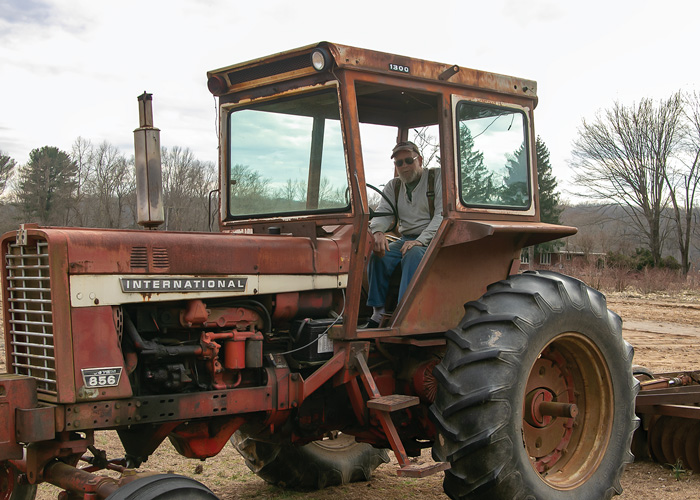
Off the top of his head, Nick remembered growing: Early Glow, Late Glow, Sparkle, Jersey Belle, Raritan, All Star, Late Star, Honey Yo, Mohawk, Delmarvel, Kent, Cavendish and Northeaster. He also remembered one called “The Albertson Berry”. That one must have been given to George by their neighbor, Earl Albertson. Whether Earl bred this plant himself or got it from someone else is a fact long gone. Each variety of strawberries has its own characteristics and qualities. One may have sweet fruit and ripen early; another has a hardy fruit that appears late in the season, a third may have smaller berry that prefers cooler weather and sandy soil. Balancing the personalities of the various types is part of the constant process of decision making required to run the operation. The Cook Agricultural School at Rutgers is still extremely active in the development of new strawberry hybrids.
Weather permitting, a crew of two workers picks as many as six hundred quarts of strawberries a day at peak season in mid-June. There is a field set aside for customers who choose to “pick-your-own”, and hundreds of quarts are sold and consumed in the field. Many people appreciate the discount on self-picked berries, and others want to choose their own berries according to their criteria of size, shape, color and degree of ripeness. Although very few self-pickers can resist sampling or even gorging themselves in the field, Nick is philosophical about it. He believes that they usually get tired of eating unwashed berries very quickly, and customers always buy much more than they can eat. “Pick-your-own” berries are the bread and butter of some farms but at Marshall’s they account for only ten percent of their strawberry crop. Half are sold wholesale; some directly to other stands or smaller grocery stores and some to a local produce distributor.
The strawberry season is short. The plants flower quickly, the fruit grows rapidly, and what remains of the plants after harvest is mowed. Only a small part of each plant remains above the ground, eliminating any disease that may have caught. The new leaves that grow in July and August are healthy and nourish the all-important root system. Even after the last berry is picked, the strawberry fields continue to be weeded. If left unchecked, the weeds will overcome the strawberry plants.
Lost crops do not represent only lost income from the sale of produce but loss of investment. Time was invested in preparing the field. Money was invested in fertilizer and plants or seeds. Nick told me of a nearby orchard operator who had recently lost his entire peach crop. The farmer’s investment was calculated at $10,000 in fertilizer, fuel and labor costs. Nick shook his head in dismay trying to calculate the amount of lost income. But Nick and Marianne have worked this land for most of their lives now. Good farmers are forces of nature. They look forward to a good year.
Marshall’s Farm Market, 114 Route 46, Delaware, 908/475-1989
The Centenary Stage Company produces professional equity theatre and also a wide variety of top-flight musical and dance events throughout the year.
Millbrook Village, part of the Delaware Water Gap National Recreation Area, is a re-created community of the 1800s where aspects of pioneer life are exhibited and occasionally demonstrated by skilled and dedicated docents throughout the village
The 8,461 acre park includes the 2500-acre Deer Lake Park, Waterloo Village, mountain bike and horseback trails.
Local roots!
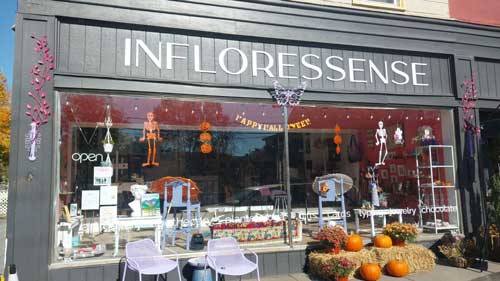
A fine art gallery like no other! Unique, handmade gifts and cards as well as yoga, meditation, and continued learning lectures. Come in Saturdays for all-day open mic and Sundays to try unique nootropic chocolate or mushroom coffee. Browse the $5 books in the Believe Book Nook while you nibble and sip.